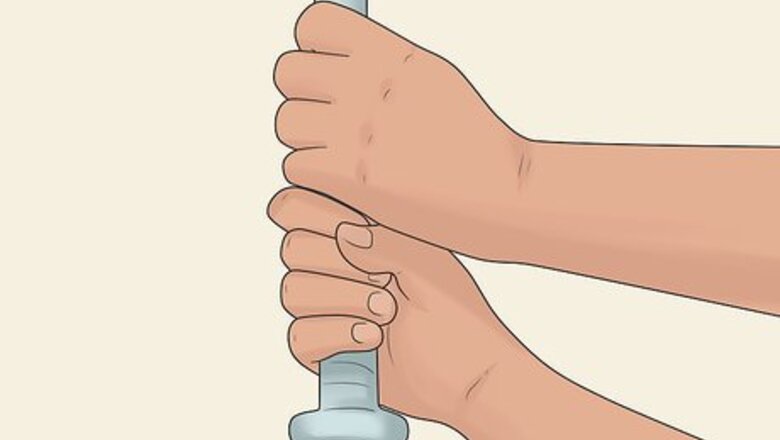
views
Achieving the Standard Grip

Place your dominant hand over your non-dominant hand on the handle. Hold your bat low on the handle. If you’re right-handed, set your right hand higher up on the handle and place your left hand close to the base of the handle. If you’re left-handed, keep your left hand over your right along the handle. A softball bat’s handle is the slender part towards the base of the bat, which is typically wrapped with a grippy tape.
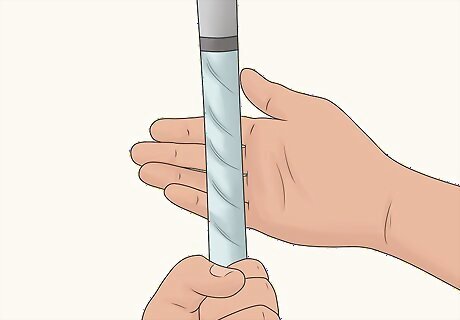
Position the bat’s handle at the base of your fingers. With your dominant hand stacked on top of your non-dominant hand, line up the handle against the base of your fingers. Keep the handle in line with the bottom set of knuckles. Keep the handle against the soft pads on the inside of your hand where you’d typically form blisters or calluses. To check to see if you’re doing this right, extend the bat out in front of you as if you’re shaking someone’s hand. The bat should rest comfortably at the base of your fingers this way. The way you hold your bat comes down to your game strategy. For instance, you might hold the bat more in your fingers to get more control, or hold it in the deeper part of your hand to get more power.
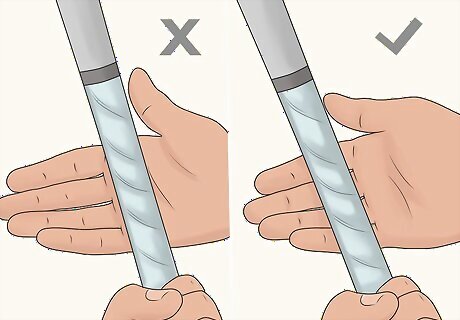
Avoid holding onto the bat with the palms of your hands. Focus on keeping the bat’s handle at the base of your fingers. Don’t grip it too far back in your palms. If you hold it with your palms, you’ll place more tension on your wrists and limit yourself from swinging quickly. You may bruise the base of your thumb if you hold the bat too far back. Use proper hand placement to avoid this injury.
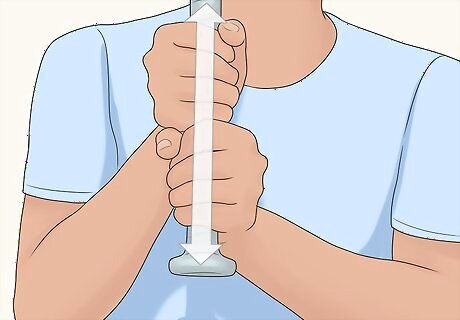
Line up your door-knocking knuckles across both hands. The door-knocking knuckles are the center ones, or the ones you’d use to knock on a door. With both hands stacked on the handle, rotate your hands so that these knuckles line up from dominant hand to your non-dominant hand. This is the hallmark of the standard softball grip. This grip encourages your top wrist to rotate naturally as you follow through on your swing. To test out your grip, lay the bat over your shoulder. Your knuckles should line up comfortably in this position.
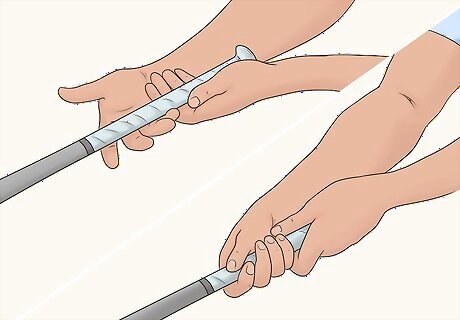
Grasp the bat lightly but firmly in your fingers. When playing softball, keep your grip light and loose. Don’t squeeze tightly on the bat or press your palms onto the handle. Keep your wrists and hand muscles loose so that you can respond quickly. If you have too stiff a grip, your swing will be slower and the impact may be more uncomfortable. When you squeeze the bat too tightly, you might lock up your arms.
Modifying the Standard Grip
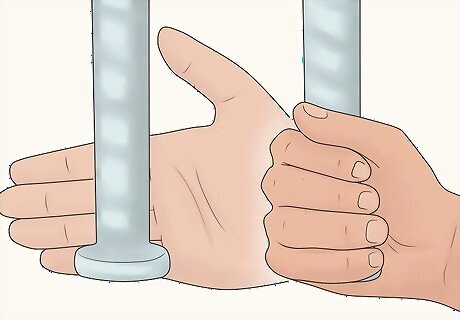
Try wrapping your bottom pinky finger around or under the knob. Position your bottom hand (your non-dominant hand) towards the very bottom edge of the handle. Then curl your pinky finger around the curved part of the knob (i.e. the bottom end of the bat). Alternatively, curl your ring finger around the knob and rest your pinky finger directly beneath the knob. With this technique, you’ll gain more control while effectively lengthening the bat. With a longer bat, you’ll get more leverage and a more powerful swing.
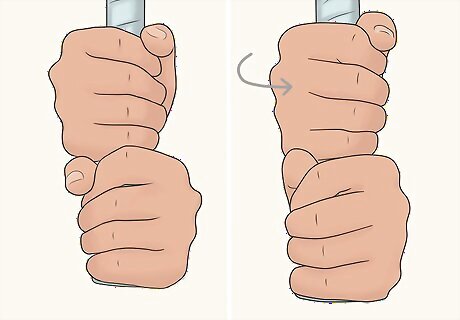
Rotate your knuckles inward for the box grip. Keep your hands stacked on the handle. Instead of lining up your door-knocking knuckles, rotate both hands slightly so that your door-knocking knuckles on 1 hand line up with your base knuckles on the other hand. Think of it as if your knuckles are straddling an imaginary center line. The box grip might give you a firmer grasp on the bat than the standard grip in which your door-knocking knuckles are aligned. Avoid rotating your hands too far inward as you won’t get a straight hit and you’ll put pressure on your wrists.
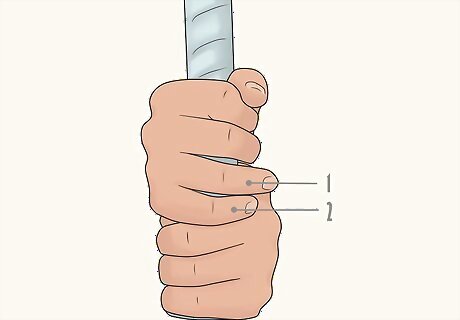
Overlap 1 or 2 of your top hand’s fingers over your bottom hand. Instead of stacking 1 hand on top of the other, slide your top, dominant hand lower down on the handle until it covers your bottom hand. Place the last 1 or 2 fingers on your top hand (i.e. your pinky and ring fingers) lightly over the knuckles on your bottom hand. Keep your top 2 or 3 fingers wrapped around the bat, and tuck your top thumb over your top index finger. Keep the fingers on your bottom hand positioned as with the standard grip. Your knuckles will no longer be in alignment across both hands; keep your middle knuckles on the top hand closer to the base knuckles on your bottom hand. This partial overlap grip can give you more topspin with more control than a total overlap.
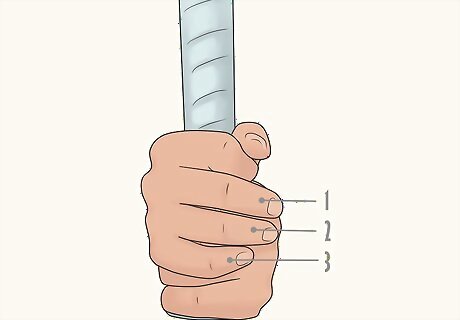
Try a full overlap by placing 3 or 4 of your top fingers over your bottom hand. Get into the partial overlap grip to start. Instead of resting 1 or 2 fingers from your top hand over your bottom hand, use 3 or 4 fingers. Try using your pinky, ring and middle fingers for a 3-finger overlap. Or go for the most extreme version of this grip by laying your index finger over your bottom hand as well. As more of an extreme grip, this will increase your bat whip but it will decrease the amount of control you have over the bat.
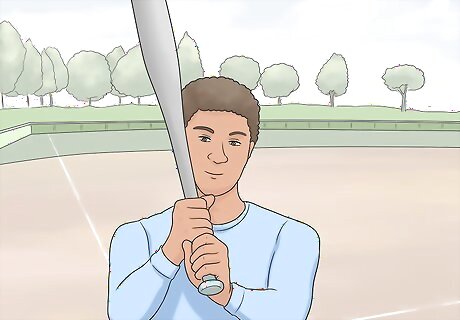
Choose the grip that feels most comfortable to you. A technique that works for another player or coach might not work as well for you. Experiment with different grip modifications during practice to see what you like and what gives you the most success. Remember that it’s okay to change your grip as long as you’re working towards finding the most comfortable and productive grip for you. Discuss your grip modifications with your coach to make sure you’re not exposing yourself to injury. Don’t wait until the game to change up your grip; you might not play as well when trying out a new grip for the first time.
















Comments
0 comment